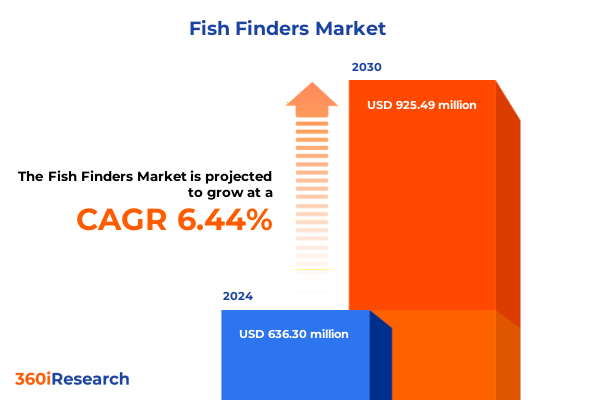The Fish Finders Market size was estimated at USD 636.30 million in 2024 and expected to reach USD 676.39 million in 2025, at a CAGR 6.44% to reach USD 925.49 million by 2030.

Introduction to the Fish Finder Market Dynamics
The fish finder market has evolved into a dynamic ecosystem where technological innovation, shifting consumer preferences, and regulatory pressures converge to shape strategic decision-making. These devices, which employ sonar and GPS technologies to detect and display underwater structures and fish, have become indispensable tools for commercial operators, professional anglers, and recreational enthusiasts alike. As the industry advances, manufacturers face both opportunities and challenges driven by the convergence of portable electronics, enhanced imaging capabilities, and the growing demand for user-friendly, data-rich interfaces. This executive summary provides an authoritative overview of the key trends influencing the fish finder landscape, offering insights into the forces that are redefining competitive advantage. Through a concise exploration of transformative shifts, tariff impacts, segmentation dynamics, regional variations, and corporate leadership, this document equips decision-makers with the clarity needed to navigate a rapidly changing environment. Ultimately, organizations that grasp these developments and act decisively will be best positioned to capitalize on emergent market opportunities and sustain long-term growth.
Transformative Shifts Reshaping the Industry Landscape
In recent years, the fish finder industry has undergone transformative shifts that reflect broader currents in digitalization, connectivity, and environmental awareness. First, the proliferation of multi-functional marine electronics has blurred the lines between standalone sonar units and integrated networked platforms, enabling boaters to access real-time mapping, weather updates, and community-driven catch logs on a single display. Concurrently, the rise of handheld and wearable fish finders has democratized advanced detection capabilities, empowering weekend anglers with the same high-fidelity imaging once reserved for commercial fleets. Moreover, the integration of artificial intelligence and machine learning into sonar analytics is enhancing species recognition and predictive fish-holding models-underscoring how software differentiation is becoming as critical as hardware performance.
Meanwhile, sustainability concerns are prompting manufacturers to adopt eco-friendly materials and power-efficient designs, responding to both regulatory scrutiny and consumer expectations. Supply chains, too, are in flux as firms reconfigure sourcing strategies to mitigate geopolitical risks. Taken together, these developments herald a new era in which agility, cross-disciplinary innovation, and responsible stewardship define market leaders.
Cumulative Impact of United States Tariffs 2025
The implementation of new United States tariffs in 2025 has reverberated across the fish finder supply chain, compelling stakeholders to re-evaluate sourcing, pricing, and manufacturing footprints. Devices incorporating imported sonar transducers or GPS modules from tariff-affected countries have seen input costs rise, squeezing margins and forcing some suppliers to absorb additional expenses to maintain end-user price points. As a result, several prominent manufacturers have initiated nearshore assembly operations and explored alternative component suppliers outside the tariff scope, thereby diversifying risk and preserving production continuity.
At the same time, the tariff adjustments have triggered strategic collaboration between original equipment manufacturers and electronics subcontractors to co-develop proprietary modules that bypass tariff classifications. Retailers, facing elevated wholesale costs, have increasingly leveraged dynamic pricing engines and tiered discount programs to maintain competitiveness, especially in the crowded online channel. Ultimately, while short-term disruptions challenged supply chain resilience, the accelerated adoption of localization strategies and tariff-smart design principles has strengthened the industry’s long-term capacity to adapt.
Key Segmentation Insights Driving Product and Marketing Strategies
Analyzing market performance through the lens of product type reveals a clear bifurcation between fixed and portable fish finders: the console-mounted and transducer-mounted systems favored by commercial fleets and serious anglers contrast with handheld units and wearable modules tailored to convenience-driven users. Technological segmentation underscores a similar dichotomy, with GPS-enabled platforms offering navigational precision alongside sonar solutions that range from three-dimensional imaging to side-scanning and CHIRP innovations. Frequency considerations play an equally pivotal role: high-frequency devices deliver granular detail in shallow waters, whereas medium frequency and low frequency units optimize depth penetration for offshore expeditions.
Power source preferences further differentiate offerings, as direct power supply systems deliver uninterrupted performance for protracted voyages, while the proliferation of rechargeable and disposable batteries has expanded the appeal of truly portable detectors. From a distribution standpoint, marine supply and specialty sporting goods outlets remain vital for hands-on demonstration of gear, yet brand websites and major e-commerce platforms are capturing a growing share of sales by offering bundled software subscriptions and remote support. Finally, user type classification spans commercial enterprises reliant on fleet-wide deployment, professional operators demanding ruggedized hardware, and recreational enthusiasts seeking affordable, entry-level solutions. Together, these segmentation dimensions inform targeted product development, tailored marketing campaigns, and differentiated service models.
This comprehensive research report categorizes the Fish Finders market into clearly defined segments, providing a detailed analysis of emerging trends and precise revenue forecasts to support strategic decision-making.
- Product Type
- Technology
- Frequency Range
- Power Source
- Sales Channel
- User Type
Key Regional Insights Shaping Market Penetration
Regional dynamics in the fish finder arena reveal distinctive growth drivers and adoption patterns. In the Americas, strong recreational fishing culture and expansive freshwater ecosystems underpin robust demand for portable, user-friendly units, while commercial fishing operations in the Gulf and South America continue to invest in heavy-duty, integrated sonar arrays. The Europe, Middle East & Africa region demonstrates appetite for premium, multisensor platforms-especially in the Mediterranean and North Sea areas-where strict maritime regulations and high consumer purchasing power encourage premium features and sustainable materials. Meanwhile, the Asia-Pacific landscape is characterized by rapid expansion in both small-boat fisheries and leisure segments, with emerging markets in Southeast Asia and Australia catalyzing demand for cost-effective, GPS-enabled solutions that combine affordability with basic sonar functionality. Across each geography, local dealer networks, channel partnerships, and region-specific warranties influence adoption rates and shape competitive positioning.
This comprehensive research report examines key regions that drive the evolution of the Fish Finders market, offering deep insights into regional trends, growth factors, and industry developments that are influencing market performance.
- Americas
- Asia-Pacific
- Europe, Middle East & Africa
Key Companies Insights Highlighting Competitive Differentiation
The competitive ecosystem is anchored by a diverse roster of established electronics giants and agile disruptors. BioSonics, Inc. distinguishes itself with specialized hydroacoustic sensors tailored to scientific research, while Deeper, UAB has pioneered castable, wireless fish finders that appeal to shore-based anglers. Furuno Electric Co., Ltd. sustains leadership through a comprehensive marine electronics suite, and Garmin Ltd. continues to set benchmarks in GPS integration and user interface design. GME Pty Ltd remains a key player in VHF and fish finder convergence, and Hawkeye Electronics by NorCross Marine Products, Inc. caters to professional fleets. Honda Motor Co., Ltd. and Humminbird by Johnson Outdoors Inc. each leverage their parent-company strengths to deliver rugged modules, whereas Japan Marina Co., Ltd. and Japan Radio Co., Ltd. focus on boutique, high-performance solutions. Koden Electronics Co., Ltd. excels in precision transducer engineering, and Marcum Technologies by Rapala VMC Corporation integrates fish-attraction lighting with sonar arrays. Navico Group by Brunswick Corporation commands market share through its Lowrance and Simrad brands, while ReelSonar by JMC Enterprises Inc. innovates with tethered sonar buoys. Samyung ENC., SI-TEX Marine Electronics, and Suzuki Fish Finder Co., Ltd. maintain regional fortes in Asia, and Teledyne Technologies Incorporated advances subsea imaging. Rounding out the field, Vexilar, Inc. continues its heritage of ice-fishing transducers. Collectively, these players drive innovation cycles and competitive intensity.
This comprehensive research report delivers an in-depth overview of the principal market players in the Fish Finders market, evaluating their market share, strategic initiatives, and competitive positioning to illuminate the factors shaping the competitive landscape.
- BioSonics, Inc.
- Deeper, UAB
- Furuno Electric Co., Ltd.
- Garmin Ltd.
- GME Pty Ltd
- Hawkeye Electronics by NorCross Marine Products, Inc.
- Honda Motor Co., Ltd.
- Humminbird by Johnson Outdoors Inc.
- Japan Marina Co.,Ltd.
- Japan Radio Co., Ltd.
- Koden Electronics Co., Ltd.
- Marcum Technologies by Rapala VMC Corporation
- Navico Group by Brunswick Corporation
- ReelSonar by JMC Enterprises Inc.
- Samyung ENC.
- SI-TEX Marine Electronics
- Suzuki Fish Finder Co., Ltd
- Teledyne Technologies Incorporated
- Vexilar, Inc.
Actionable Recommendations for Industry Leaders
To capitalize on emerging trends and mitigate risk exposures, industry leaders should consider several actionable recommendations. First, prioritize modular architectures that allow for rapid firmware updates and seamless integration of future sonar or navigation enhancements. Second, diversify the supplier base by establishing partnerships in low-tariff jurisdictions and investing in in-house component development to reduce dependency on external vendors. Third, accelerate the rollout of hybrid power systems that combine direct power with high-capacity battery backup, catering to both professional marinas and remote anglers. Fourth, enhance digital ecosystems by offering tiered subscription services-such as AI-driven species identification and community analytics-to create recurring revenue streams and bolster customer loyalty. Fifth, reinforce global distribution strategies through selective alliances with maritime dealers, specialty retailers, and leading e-commerce platforms, ensuring both hands-on support and seamless online purchasing experiences. Finally, embed sustainability in product design-utilizing recyclable plastics and energy-efficient processing-to resonate with environmentally conscious stakeholders and stay ahead of regulatory shifts.
Explore AI-driven insights for the Fish Finders market with ResearchAI on our online platform, providing deeper, data-backed market analysis.
Ask ResearchAI anything
World's First Innovative Al for Market Research
Conclusion: Navigating Future Growth with Strategic Precision
The fish finder market stands at a pivotal juncture defined by rapid technological convergence, evolving trade policies, and diverse consumer segments. Organizations that embrace modular innovation, supply-chain agility, and digital service offerings will outpace competitors and capture new revenue opportunities. By understanding the nuanced segmentation across product form factors, sonar capabilities, and user profiles, firms can tailor go-to-market strategies that resonate with targeted audiences. Regional distinctions underscore the importance of channel optimization and localization, while competitive analysis highlights best practices in feature differentiation and brand positioning. Moving forward, the most successful players will be those that seamlessly integrate hardware excellence with software-driven value, all while navigating tariff complexities and sustainability imperatives. This balanced approach will ensure resilience in the face of regulatory headwinds and reinforce long-term leadership in a market fueled by innovation and user experience.
This section provides a structured overview of the report, outlining key chapters and topics covered for easy reference in our Fish Finders market comprehensive research report.
- Preface
- Research Methodology
- Executive Summary
- Market Overview
- Market Dynamics
- Market Insights
- Cumulative Impact of United States Tariffs 2025
- Fish Finders Market, by Product Type
- Fish Finders Market, by Technology
- Fish Finders Market, by Frequency Range
- Fish Finders Market, by Power Source
- Fish Finders Market, by Sales Channel
- Fish Finders Market, by User Type
- Americas Fish Finders Market
- Asia-Pacific Fish Finders Market
- Europe, Middle East & Africa Fish Finders Market
- Competitive Landscape
- ResearchAI
- ResearchStatistics
- ResearchContacts
- ResearchArticles
- Appendix
- List of Figures [Total: 28]
- List of Tables [Total: 544 ]
Call-To-Action: Connect with Ketan Rohom for the Full Market Research Report
For a deeper exploration of these insights and to equip your organization with comprehensive market intelligence, contact Ketan Rohom, Associate Director, Sales & Marketing at 360iResearch. Engage today to secure strategic guidance and actionable data that will inform your next phase of growth.

- How big is the Fish Finders Market?
- What is the Fish Finders Market growth?
- When do I get the report?
- In what format does this report get delivered to me?
- How long has 360iResearch been around?
- What if I have a question about your reports?
- Can I share this report with my team?
- Can I use your research in my presentation?




